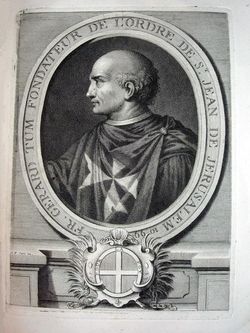Blessed Gerard
| Blessed Gerard | |
|---|---|

18th-century copper engraving by Laurent Cars, captioned Brother Gerard Tum, Founder of the Order of St John of Jerusalem 1099.
|
|
| Rector of the Hospital | |
| Born | c. 1040 Europe |
| Died | 3 September 1120 Jerusalem |
| Venerated in | Roman Catholic Church |
| Major shrine | Monastery of St. Ursula, Valletta, Malta |
| Feast | October 13 |
| Patronage | Day of Emergency Medicine (Poland) |
The Blessed Gerard (c. 1040 – 3 September 1120) was a lay brother in the Benedictine order who was appointed as rector of the hospice in Jerusalem in 1080, and who, in the wake of the success of the First Crusade in 1099, became the founder of the Order of St John of Jerusalem (Knights Hospitaller) (papal recognition in 1113).
In French sources, Gerard is sometimes known as Gérard (sometimes Pierre-Gérard) de Martigues due to a tradition of his place of birth being Martigues, Provence. However, William of Tyre, writing in the late 12th century, cites Amalfi as Gerard's birthplace. This is not implausible, as merchants from Amalfi were involved in the reconstruction of the hospice in Jerusalem in the 1020s, after its destruction in 1005 under caliph Al-Hakim bi-Amr Allah. A local historian of Amalfi, Giuseppe Gargano, has proposed an identity of Gerard with a certain Gerard Sasso on record in the city of Amalfi.
An alleged surname Tum, variously also Thom, Tune or Tenque, is due to an error by Pierre-Joseph de Haitze (1730), who mistook the word tunc "then" as a name of Gerard. De Haitze's mistake was identified in 1885 by Ferdinand de Hellwald. Before the erroneous nature of the surname Tunc became clear, Italian historian Francesco Galeani Napione (d. 1830) italianized Gerardus Tunc as Gerardo da Tonco, suggesting that he was a native of (or held possessions in) Tonco in Piedmont.
Little is known about Gerard's life; his nationality and place of birth is unknown (tradition makes him a native of either Amalfi or Lower Burgundy (Provence). He most likely was a Benedictine lay brother, possibly one of the frates conversi (i.e. men who joined the order not as boys or youths but after spending part of their adult years leading a secular life) who came to the Holy Land to serve at the abbey of St. Mary of the Latins. In c. 1080, the abbot put him in charge of the Hospital of St. John in Jerusalem, which had been built on the site of the monastery of Saint John the Baptist in the 1060s in addition to the older hospice rebuilt in the 1020s.
...
Wikipedia
